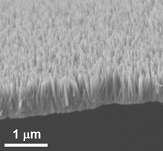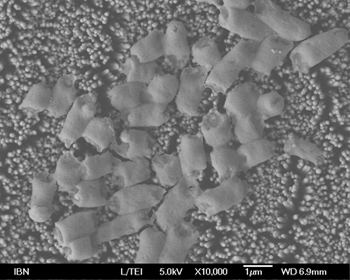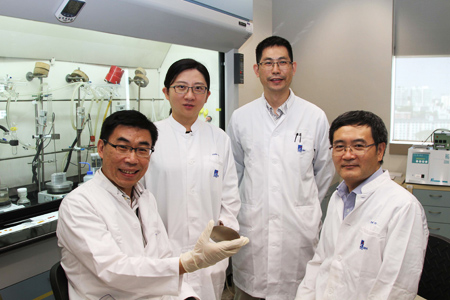A*STAR NEWS
Dragonfly-inspired nano coating kills bacteria upon contact
Singapore- March 28- 2018 – Studies have shown that the wings of dragonflies and cicadas prevent bacterial growth due to their natural structure. The surfaces of their wings are covered in nanopillars making them look like a bed of nails. When bacteria come into contact with these surfaces- their cell membranes get ripped apart immediately and they are killed. This inspired researchers from the Institute of Bioengineering and Nanotechnology (IBN) of A*STAR to invent an anti-bacterial nano coating for disinfecting frequently touched surfaces such as door handles- tables and lift buttons. This technology will prove particularly useful in creating bacteria-free surfaces in places like hospitals and clinics- where sterilization is important to help control the spread of infections. Their new research was recently published in the journal Small.
80% of common infections are spread by hands- according to the B.C. Centre for Disease Control1. Disinfecting commonly touched surfaces helps to reduce the spread of harmful germs by our hands- but would require manual and repeated disinfection because germs grow rapidly. Current disinfectants may also contain chemicals like triclosan which are not recognized as safe and effective 2- and may lead to bacterial resistance and environmental contamination if used extensively.
“There is an urgent need for a better way to disinfect surfaces without causing bacterial resistance or harm to the environment. This will help us to prevent the transmission of infectious diseases from contact with surfaces-” said IBN Executive Director Professor Jackie Y. Ying.
To tackle this problem- a team of researchers led by IBN Group Leader Dr Yugen Zhang created a novel nano coating that can spontaneously kill bacteria upon contact. Inspired by studies on dragonflies and cicadas- the IBN scientists grew nanopilllars of zinc oxide- a compound known for its anti-bacterial and non-toxic properties. The zinc oxide nanopillars can kill a broad range of germs like E. coli and S. aureus that are commonly transmitted from surface contact.
Tests on ceramic- glass- titanium and zinc surfaces showed that the coating effectively killed up to 99.9% of germs found on the surfaces. As the bacteria are killed mechanically rather than chemically- the use of the nano coating would not contribute to environmental pollution. Also- the bacteria will not be able to develop resistance as they are completely destroyed when their cell walls are pierced by the nanopillars upon contact.
Further studies revealed that the nano coating demonstrated the best bacteria killing power when it is applied on zinc surfaces- compared with other surfaces. This is because the zinc oxide nanopillars catalyzed the release of superoxides (or reactive oxygen species)- which could even kill nearby free floating bacteria that were not in direct contact with the surface. This super bacteria killing power from the combination of nanopillars and zinc broadens the scope of applications of the coating beyond hard surfaces.
Subsequently- the researchers studied the effect of placing a piece of zinc that had been coated with zinc oxide nanopillars into water containing E. coli. All the bacteria were killed- suggesting that this material could potentially be used for water purification.
Dr Zhang said- “Our nano coating is designed to disinfect surfaces in a novel yet practical way. This study demonstrated that our coating can effectively kill germs on different types of surfaces- and also in water. We were also able to achieve super bacteria killing power when the coating was used on zinc surfaces because of its dual mechanism of action. We hope to use this technology to create bacteria-free surfaces in a safe- inexpensive and effective manner- especially in places where germs tend to accumulate.”
IBN has recently received a grant from the National Research Foundation- Prime Minister’s Office- Singapore- under its Competitive Research Programme to further develop this coating technology in collaboration with Tan Tock Seng Hospital for commercial application over the next 5 years.
1 B.C. Centre for Disease Control
2 U.S. Food & Drug Administration
Reference:
- Guangshun Yi- Yuan Yuan- Xiukai Li and Yugen Zhang- “ZnO Nanopillar Coated Surfaces with Substrate-Dependent Superbactericidal Property-” Small- (2018)
DOI: 10.1002/smll.201703159. See article
Images:
Image 1: Zinc oxide nanopillars that looked like a bed of nails can kill a broad range of germs when used as a coating on frequently-touched surfaces.
Image 2: E. coli bacteria destroyed by the anti-bacterial coating made from zinc oxide nanopillars.
Image 3: The researchers from IBN - clockwise from left- Dr Guangshun Yi- Dr Yuan Yuan- Dr Xiukai Li and Dr Yugen Zhang- who developed the dragonfly-inspired nano coating that can kill bacteria spontaneously upon contact. Dr Yi is holding up a piece of zinc coated with zinc oxide nanopillars.
The Institute of Bioengineering and Nanotechnology (IBN) is the world’s first bioengineering and nanotechnology research institute. Established in 2003- IBN’s mission is to conduct multidisciplinary research across science- engineering- and medicine for breakthroughs to improve healthcare and quality of life. IBN’s research activities are focused on Nanomedicine- Synthetic Biosystems- Biodevices and Diagnostics- and Green Chemistry and Energy. The Institute has published over 1-320 papers in leading scientific journals- filed over 660 active patents and patent applications on its inventions- and established 12 spin-off companies. To nurture young research talents- IBN runs a Youth Research Program that offers students research attachment opportunities and exposure to biomedical research. For more information on IBN- please visit www.a-star.edu.sg/ibn.
About the Agency for Science- Technology and Research
The Agency for Science- Technology and Research (A*STAR) is Singapore's lead public sector agency that spearheads economic oriented research to advance scientific discovery and develop innovative technology. Through open innovation- we collaborate with our partners in both the public and private sectors to benefit society.
As a Science and Technology Organization- A*STAR bridges the gap between academia and industry. Our research creates economic growth and jobs for Singapore- and enhances lives by contributing to societal benefits such as improving outcomes in healthcare- urban living- and sustainability.
We play a key role in nurturing and developing a diversity of talent and leaders in our Agency and Research Institutes- the wider research community and industry. A*STAR oversees 18 biomedical sciences and physical sciences and engineering research entities primarily located in Biopolis and Fusionopolis.
About the National Research Foundation Competitive Research Programme
The National Research Foundation Competitive Research Programme funding scheme seeks to foster the formation of multi-disciplinary teams to conduct cutting-edge research projects that are of relevance to Singapore and the society. The Competitive Research Programme funds use-inspired basic research projects that are selected through a merit review process based on scientific excellence. The theme of the proposed research project must be motivated by an important need or problem to be solved. Past projects have made discoveries of potential significant impact to industry and society.
Was This Article Helpful ?
A*STAR celebrates International Women's Day

From groundbreaking discoveries to cutting-edge research, our researchers are empowering the next generation of female science, technology, engineering and mathematics (STEM) leaders.
Get inspired by our #WomeninSTEM



